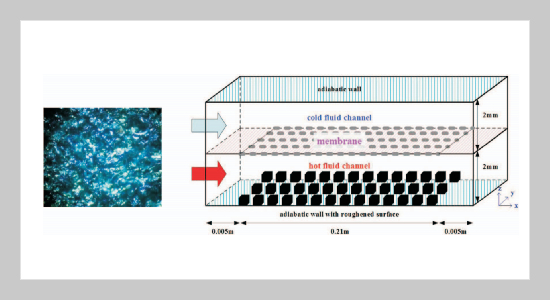REFERENCES
- [1] Camacho, L. M., Dumée, L., Zhang, J., Li, J., Duke, M., Gomez, J. and Gray, S., “Advances in Membrane Distillation for Water Desalination and Purification Applications,” Water, Vol. 5, No. 1, pp. 94196 (2013). doi: 10.3390/w5010094
- [2] Ho, C.-D., Chang, H., Chang, C.-L. and Huang, C.-H., “Theoretical and Experimental Studies of Performance Enhancement with Roughened Surface in Direct Contact Membrane Distillation Desalination,”Journal of Membrane Science, Vol. 433, pp. 160166 (2013). doi: 10.1016/j.memsci.2012.12.044
- [3] Lawson, K. W. and Lloyd, D. R., “Membrane Distillation,” Journal of Membrane Science, Vol. 124, No. 1, pp. 125 (1997). doi: 10.1016/S0376-7388(96)00236-0
- [4] Gryta, M., Tomaszewska, M. and Morawski, A. W., “Membrane Distillation with Laminar Flow,” Separation and Purification Technology, Vol. 11, No. 2, pp. 93101 (1997). doi: 10.1016/S1383-5866(97)00002-6
- [5] Gryta, M. and Tomaszewska, M., “Heat Transport in the Membrane Distillation Process,” Journal of Membrane Science, Vol. 144, pp. 211222 (1998). doi: 10. 1016/S0376-7388(98)00050-7
- [6] Qtaishat, M., Matsuura, T., Kruczek, B. and Khayet, M., “Heat and Mass Transfer Analysis in Direct Contact Membrane Distillation,” Desalination, Vol. 219, pp. 272292 (2008). doi: 10.1016/j.desal.2007.05.019
- [7] Chang, H., Liau, J.-S., Ho, C.-D. and Wang, W.-H., “Simulation of Membrane Distillation Modules for Desalination by Developing User’s Model in Aspen Plus Platform,” Desalination, Vol. 249, No. 1, pp. 380387 (2009). doi: 10.1016/j.desal.2008.11.026
- [8] Bui, V. A., Vu, L. T. T. and Nguyen, M. H., “Modelling the Simultaneous Heat and Mass Transfer of Direct Contact Membrane Distillation in Hollow Fibre Modules,” Journal of Membrane Science, Vol. 353, pp. 8593 (2010). doi: 10.1016/j.memsci.2010.02.034
- [9] Charfi, K., Khayet, M. and Safi, M. J., “Numerical Simulation and Experimental Studies on Heat and Mass Transfer Using Sweeping Gas Membrane Distillation,” Desalination, Vol. 259, pp. 8496 (2010). doi: 10.1016/ j.desal.2010.04.028
- [10] Yu, H., Yang, X., Wang, R. and Fane, A. G., “Numerical Simulation of Heat and Mass Transfer in Direct Membrane Distillation in a Hollow Fiber Module with Laminar Flow,” Journal of Membrane Science, Vol. 384, pp. 107116 (2011). doi: 10.1016/j.memsci.2011. 09.011
- [11] Shakaib, M., Hasani, S. M. F., Ahmed, I. and Yunus, R. M., “A CFD Study on the Effect of Spacer Orientation on Polarization in Membrane Distillation Modules,” Desalination, Vol. 284, pp. 332340 (2012). doi: 10. 1016/j.desal.2011.09.020
- [12] Yu, H., Yang, X., Wang, R. and Fane, A. G., “Analysis of Heat and Mass Transfer by CFD for Performance Enhancement Indirect Contact Membrane Distillation,” Journal of Membrane Science, Vol. 405, pp. 3847 (2012). doi: 10.1016/j.memsci.2012.02.035
- [13] Yang, X., Yu, H., Wang, R. and Fane, A. G., “Analysis of the Effect of Turbulence Promoters in Hollow Fiber Membrane Distillation Modules by Computational Fluid Dynamic (CFD) Simulations,” Journal of Membrane Science, Vol. 415, pp. 758769 (2012). doi: 10.1016/j. memsci.2012.05.067
- [14] Yang, X., Yu, H., Wang, R. and Fane, A. G., “Optimization of Microstructured Hollow Fiber Design for Membrane Distillation Applications Using CFD Modeling,” Journal of Membrane Science, Vol. 421, pp. 258270 (2012). doi: 10.1016/j.memsci.2012.07.022
- [15] Fluent Inc., Fluent 6.3 User’s Guide (2006).
- [16] Mason, E. A. and Malinauskas, A. P., Gas Transport in Porous Media: The Dusty-Gas Model, Elsevier, New York (1983).
- [17] Khayet, M., Velazquez, A. and Mengual, J. I., “Modelling Mass Transport through a Porous Partition: Effect of Pore Size Distribution,” Journal of Non-Equilibrium Thermodynamics, Vol. 29, pp. 279299 (2005). doi: 10.1515/JNETDY.2004.055
- [18] Warner, S. B., Fiber Science, Prentice-Hall, Englewood Cliffs, New Jersey (1995).
- [19] Churchill, S. W. and Ozoe, H., “Correlations for Laminar Forced Convection with Uniform Heating in Flow over a Plate and in Developing and Fully Developed Flow in a Tube,” Journal of Heat Transfer, Vol. 95, No. 4, pp. 7884 (1973). doi: 10.1115/1.3450121
- [20] Churchill, S. W. and Ozoe, H., “Correlations for Laminar Forced Convection with Uniform Heating in Flow over a Plate and in Developing and Fully Developed Flow in a Tube,” Journal of Heat Transfer, Vol. 95, No. 4, pp. 416419 (1973). doi: 10.1115/1.3450121
- [21] Shah, R. K. and Bhatti, M. S., “Laminar Convective Heat Transfer in Ducts,” in: Kakac, S., Shan, R. K. and Aung, W., (Eds.), Handbook of Single Phase Convective Heat Transfer, John Wiley & Sons, New York (1987).
- [22] Staniszewski, B., Heat Exchange, PWN, Warsaw (1980).
- [23] Kakac, S., Shan, R. K. and Bergles, A. E., Low Reynolds Number Flow Heat Exchangers, Hemisphere, Washington, D.C. (1983).
- [24] Shah, R. K. and London, A. L., Advances in Heat Transfer, Supplement 1, Laminar Forced Flow Convection in Ducts, Academic Press, New York (1978).
- [25] Hausen, H., “Darstellung des Warmeuberganges in Rohren Durch Verallgemeinerte Potenzbeziehyngen,” VDI-Verfahrenstechnik, Vol. 4, pp. 91134 (1943).
















